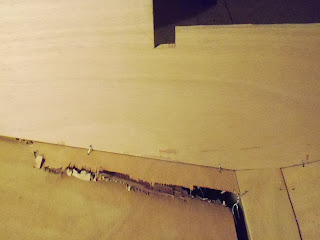Before I whine about filleting here are a few pictures before and after with the transom.
 |
| The repair to the cracked hull can be seen here on the left of the keelson at the base of the bulkhead. |
 |
| Here is the complex corner where the transom meets the hull and sides. |
The transom fit beautifully although I will admit that until the moment I positioned it in place I doubted it would fit that shape of space. It did.
So next I got my introduction to filleting. It initially was awful. My fillets were sticky and pockmarked but with time they became better. I have about a 2 hour window in the mornings when my garage goes below 90 degrees and I can do my epoxy mixing.
 |
| Fillets near transom |
 |
| Messy fillet over keelson. It looks like I had a food fight! |
This fillet started out awful. It's where the keelson meets the transom. The hull is so flat here that I was afraid that the fillets would be too thin as a result. So I ended up filling in that whole strip and making it one big fillet. It was one area wher I was able to lay on the fiberglass cloth before the fillet cured and it turned out to be a large but very smooth and solid joint.
Sanding these joints is awful so the motivation grows to make succesive fillets smoother. I found that my Rockwell multitool mwith the triangular sanding pad worked great in those hard to reach corners.
After too many hours of sanding it was time to lay down the fiberglass
 |
| Laying out before epoxy |














































